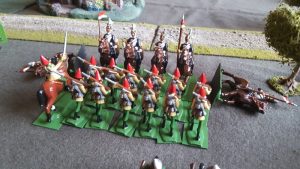The background…
1895 – Following his gallant stand at the Coldstream bridge, Sir William Hullough-Casting was forced to retire towards Berwick before the Russians completed their encirclement of the town. With British forces in Scotland neutralised by Russian occupation, and Crown forces in the South and West, much reduced in number and fending off incursions by French marine raiders, the situation looked bleak. Ireland was in turmoil, and British forces there were committed to fighting a Fenian uprising which was taking advantage of the international crisis, and fomented by agents of the Kaiser.
The only reserves of any note were being gathered in the east of the country, with troops being mustered from whatever source possible. Active and energetic in this, Brigadier Inigo Hardly-Standing had brought together a field force from several disparate elements, including two celebrated units of the Indian Army who had been in London as part of that year’s Royal Tournament. Thanks to his Herculean efforts Hardly-Standing formed the Eastern Command Field Force, and following a flurry of telegraphic communication with Sir William Hullough-Casting this force prepared to march to the relief of Berwick. Sir William agreed to meet the Eastern Command Field Force at Scarborough.
So the field force was entrained at Ipswich to head northwards. However on reaching Boston in Lincolnshire railway authorities reported to the Brigadier that the lines had been cut outside Grimsby. Dispatching mounted scouts Hardly-Standing learnt that a large French force had landed at Skegness and had joined with a Russian naval force which had landed and taken Grimsby three days earlier. Other, unknown military units had been reported supporting the Franco-Russian army which was now marching eastward. Hardly-Standing could not be sure as to the purpose of this landing, it could be the Russian intention to cut off the Midlands and East Anglia from the north, or even march on the south and London. He was the man on the spot and in command of the only sizeable British force that could deal with this new threat. There was good news however.
In response to appeals for help, a small expeditionary force comprised of troops from the minor German principalities had landed at Kings Lynn. This coalition had been formed to oppose Prussian expansionism, and being aware of the real powers at work in this crisis had offered their help to Britain, an offer which was gratefully accepted, the British being desperately short of trained troops at home.
Hardly-Standing posted piquets and vedettes on the approach roads to Boston whilst he organised his forces to meet the threat. With this new influx of forces he was able to put a comparable force into the field against the Franco-Prussians and their lackeys.
Such were the events leading up to the great battles that took place this weekend in The Crown Hotel, Framlingham. Tim Hall and Simon Tonkiss had done a great job organising the event and providing most of the troops. Others (Tim Waudby, myself, Iain Burt, Paul Bright, Mark Philips and Dave McUmphla) had supplied some of their own to greater or lesser degrees. Day 1 saw me facing Mark Philips (Peeler) on the right of the line. My small force was combined with a larger Russian force:
And faced a strong British force who unexpectedly arrived down the road on the flank rather than at the opposing base line:
I tried to advance rapidly to seize the hedge line before the British force could deploy but this did not happen and my central troops only reached the field.
With my cavalry deployed to the right I was faced with either standing and waiting for the British guns to start taking their toll or try and attack the troops now at the hedge. And having not really read the rules properly I mistakenly thought my Guard Cuirassiers might stand a chance against what turned out to be the Grenadier Guards!
Simon was most upset…
This really marked the end of my cavalry action on that flank. The remaining heavy cavalry and cossacks were not happy and retired and milled about, unable to risk getting close to two full battalions and a field gun. They did however stop these units influencing what was a rather bloody battle across the central field as Russian marines, jaegers and a machine gun did battle with British riflemen and cavalry!
This fight was to prove inconclusive.
Meanwhile, on the left my Savage Swans and Jaegers finally advanced to entice forward the two regiments of light and heavy cavalry there. The jaegers running forward and shooting and then shooting and retiring.
Evenually this goaded the cavalry to attempt a charge to run them down. They evaded back through the Swans and the heavy cavalry, not having the move to make contact, stayed where they were but the lancers charged onwards and in. Only to be seen off!
It was at this point we called time. The overall battle had been decided on the other three sections of the table where a British victory was declared. However, it was decided (by me and Paul Bright) that my troops had stopped the British on that flank and could claim a success or at least a winning draw. Peeler, unsurprisingly disagreed! 🙂
Here are the rest of the pics with a few from other parts of the table.
[Not a valid template]
The rules used were Howard Whitehouse’s upcoming A Gentlemen’s War rules. These are aimed a toy soldier type games but have some great and fun mechanics. We really enjoyed them!
Day 2 coming soon…










Looks like a fun action. I enjoyed reading this. Thankyou for sharing.